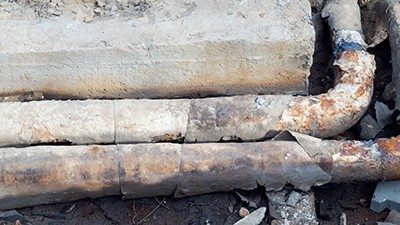FOR IMMEDIATE RELEASE
ACS News Service Weekly PressPac: August 18, 2021
Leaky sewers are likely responsible for large amounts of medications in streams
“Dosing the Coast: Leaking Sewage Infrastructure Delivers Large Annual Doses and Dynamic Mixtures of Pharmaceuticals to Urban Rivers”
Environmental Science & Technology
Pharmaceutical compounds can harm the environment. However, in waterways that don’t receive treated wastewater, these pollutants aren’t expected to be present. Now, researchers reporting in ACS’ Environmental Science & Technology have found that amounts of some medications carried by a stream in Baltimore were substantial, despite generally low concentrations over the course of a year. Because wastewater plants don’t impact this stream, the high loads are likely coming from leaking sewer pipes, they say.
Thousands of medications are approved for human use in the U.S., and many of them are harmful to microorganisms, algae and insects when they make their way into lakes and streams through wastewater. The concentrations of pharmaceutical compounds are usually used to determine their impact on organisms living in streams and rivers. However, contaminant concentrations may change quickly from one day to the next, and so singular snapshots do not correctly illustrate their cumulative effects on aquatic life. Instead, load — the mass of a pollutant that passes through a stream or river over time — better represents the risks to downstream environments, where the contaminants end up. While loads are used in regulations for traditional pollutants, such as nutrients, they have not been considered for pharmaceuticals. So, Megan Fork and colleagues wanted to get an idea of the yearly load of medicines transported by an urban stream in Baltimore.
The researchers tested water from an urban stream draining into Baltimore’s Inner Harbor in Maryland on a weekly basis for a year. At the outflow point, they found 16 pharmaceutical compounds whose presence and amount varied considerably from week to week, ranging from concentrations of parts per trillion to parts per billion. Trimethoprim — an antibiotic — was found most regularly, but acetaminophen — a common pain reliever — was at the highest concentrations. The team used their weekly measurements to estimate annual loads of pharmaceuticals, calculating that the equivalent of 30,000 doses of antidepressants, 1,700 doses of antibiotics and 30,000 tablets of acetaminophen entered the Inner Harbor through the stream. Interestingly, this watershed did not receive wastewater treatment plant effluent, so it’s likely these compounds are coming from leaky sewer pipes. Improvements to aging infrastructure could reduce this source of harmful compounds to urban streams and other waterways, the researchers say.
The authors acknowledge funding from the U.S. National Science Foundation.
###
The American Chemical Society (ACS) is a nonprofit organization chartered by the U.S. Congress. ACS’ mission is to advance the broader chemistry enterprise and its practitioners for the benefit of Earth and all its people. The Society is a global leader in promoting excellence in science education and providing access to chemistry-related information and research through its multiple research solutions, peer-reviewed journals, scientific conferences, eBooks and weekly news periodical Chemical & Engineering News. ACS journals are among the most cited, most trusted and most read within the scientific literature; however, ACS itself does not conduct chemical research. As a leader in scientific information solutions, its CAS division partners with global innovators to accelerate breakthroughs by curating, connecting and analyzing the world’s scientific knowledge. ACS’ main offices are in Washington, D.C., and Columbus, Ohio.
To automatically receive press releases from the American Chemical Society, contact newsroom@acs.org.
Note: ACS does not conduct research, but publishes and publicizes peer-reviewed scientific studies.
Media Contact
ACS Newsroom
newsroom@acs.org


